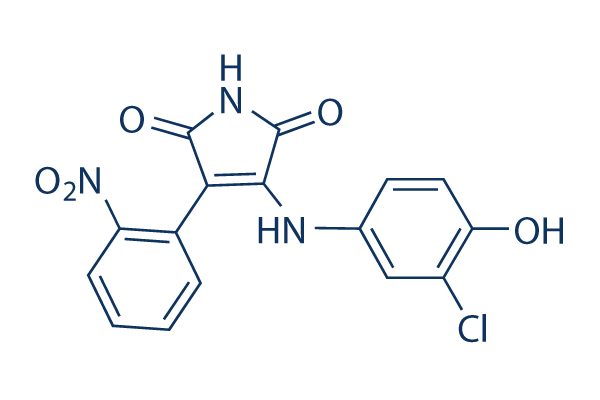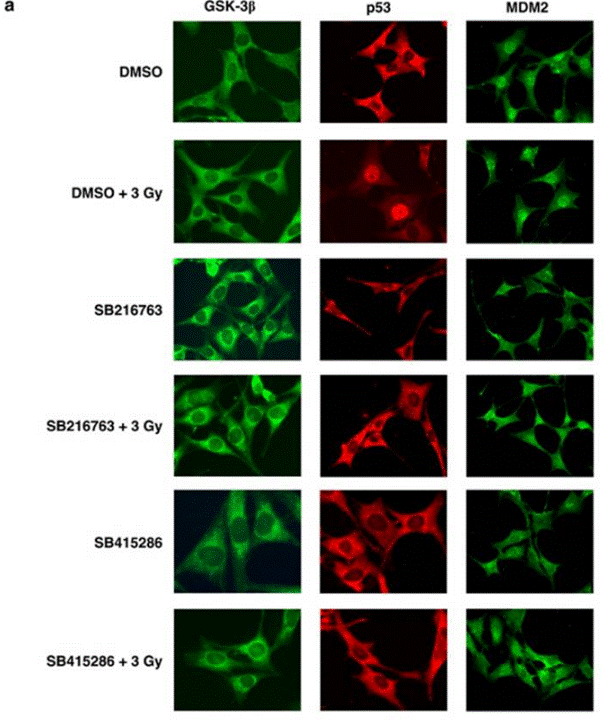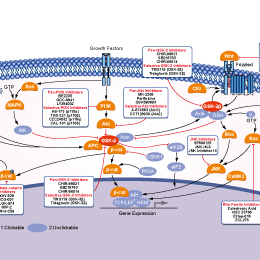
- Bioactive Compounds
- By Signaling Pathways
- PI3K/Akt/mTOR
- Epigenetics
- Methylation
- Immunology & Inflammation
- Protein Tyrosine Kinase
- Angiogenesis
- Apoptosis
- Autophagy
- ER stress & UPR
- JAK/STAT
- MAPK
- Cytoskeletal Signaling
- Cell Cycle
- TGF-beta/Smad
- DNA Damage/DNA Repair
- Compound Libraries
- Popular Compound Libraries
- Customize Library
- Clinical and FDA-approved Related
- Bioactive Compound Libraries
- Inhibitor Related
- Natural Product Related
- Metabolism Related
- Cell Death Related
- By Signaling Pathway
- By Disease
- Anti-infection and Antiviral Related
- Neuronal and Immunology Related
- Fragment and Covalent Related
- FDA-approved Drug Library
- FDA-approved & Passed Phase I Drug Library
- Preclinical/Clinical Compound Library
- Bioactive Compound Library-I
- Bioactive Compound Library-Ⅱ
- Kinase Inhibitor Library
- Express-Pick Library
- Natural Product Library
- Human Endogenous Metabolite Compound Library
- Alkaloid Compound LibraryNew
- Angiogenesis Related compound Library
- Anti-Aging Compound Library
- Anti-alzheimer Disease Compound Library
- Antibiotics compound Library
- Anti-cancer Compound Library
- Anti-cancer Compound Library-Ⅱ
- Anti-cancer Metabolism Compound Library
- Anti-Cardiovascular Disease Compound Library
- Anti-diabetic Compound Library
- Anti-infection Compound Library
- Antioxidant Compound Library
- Anti-parasitic Compound Library
- Antiviral Compound Library
- Apoptosis Compound Library
- Autophagy Compound Library
- Calcium Channel Blocker LibraryNew
- Cambridge Cancer Compound Library
- Carbohydrate Metabolism Compound LibraryNew
- Cell Cycle compound library
- CNS-Penetrant Compound Library
- Covalent Inhibitor Library
- Cytokine Inhibitor LibraryNew
- Cytoskeletal Signaling Pathway Compound Library
- DNA Damage/DNA Repair compound Library
- Drug-like Compound Library
- Endoplasmic Reticulum Stress Compound Library
- Epigenetics Compound Library
- Exosome Secretion Related Compound LibraryNew
- FDA-approved Anticancer Drug LibraryNew
- Ferroptosis Compound Library
- Flavonoid Compound Library
- Fragment Library
- Glutamine Metabolism Compound Library
- Glycolysis Compound Library
- GPCR Compound Library
- Gut Microbial Metabolite Library
- HIF-1 Signaling Pathway Compound Library
- Highly Selective Inhibitor Library
- Histone modification compound library
- HTS Library for Drug Discovery
- Human Hormone Related Compound LibraryNew
- Human Transcription Factor Compound LibraryNew
- Immunology/Inflammation Compound Library
- Inhibitor Library
- Ion Channel Ligand Library
- JAK/STAT compound library
- Lipid Metabolism Compound LibraryNew
- Macrocyclic Compound Library
- MAPK Inhibitor Library
- Medicine Food Homology Compound Library
- Metabolism Compound Library
- Methylation Compound Library
- Mouse Metabolite Compound LibraryNew
- Natural Organic Compound Library
- Neuronal Signaling Compound Library
- NF-κB Signaling Compound Library
- Nucleoside Analogue Library
- Obesity Compound Library
- Oxidative Stress Compound LibraryNew
- Plant Extract Library
- Phenotypic Screening Library
- PI3K/Akt Inhibitor Library
- Protease Inhibitor Library
- Protein-protein Interaction Inhibitor Library
- Pyroptosis Compound Library
- Small Molecule Immuno-Oncology Compound Library
- Mitochondria-Targeted Compound LibraryNew
- Stem Cell Differentiation Compound LibraryNew
- Stem Cell Signaling Compound Library
- Natural Phenol Compound LibraryNew
- Natural Terpenoid Compound LibraryNew
- TGF-beta/Smad compound library
- Traditional Chinese Medicine Library
- Tyrosine Kinase Inhibitor Library
- Ubiquitination Compound Library
-
Cherry Picking
You can personalize your library with chemicals from within Selleck's inventory. Build the right library for your research endeavors by choosing from compounds in all of our available libraries.
Please contact us at [email protected] to customize your library.
You could select:
- Antibodies
- Bioreagents
- qPCR
- 2x SYBR Green qPCR Master Mix
- 2x SYBR Green qPCR Master Mix(Low ROX)
- 2x SYBR Green qPCR Master Mix(High ROX)
- Protein Assay
- Protein A/G Magnetic Beads for IP
- Anti-Flag magnetic beads
- Anti-Flag Affinity Gel
- Anti-Myc magnetic beads
- Anti-HA magnetic beads
- Magnetic Separator
- Poly DYKDDDDK Tag Peptide lyophilized powder
- Protease Inhibitor Cocktail
- Protease Inhibitor Cocktail (EDTA-Free, 100X in DMSO)
- Phosphatase Inhibitor Cocktail (2 Tubes, 100X)
- Cell Biology
- Cell Counting Kit-8 (CCK-8)
- Animal Experiment
- Mouse Direct PCR Kit (For Genotyping)
- New Products
- Contact Us
SB415286
SB415286 is a potent GSK3α inhibitor with IC50/Ki of 78 nM/31 nM with equally effective inhibition of GSK-3β. SB415286 causes MM cell growth arrest and apoptosis.

SB415286 Chemical Structure
CAS No. 264218-23-7
Purity & Quality Control
Batch:
S272901
DMSO]72 mg/mL]false]Ethanol]72 mg/mL]false]Water]Insoluble]false
Purity:
99.74%
99.74
SB415286 Related Products
| Related Targets | GSK-3α GSK-3β | Click to Expand |
|---|---|---|
| Related Products | Laduviglusib (CHIR-99021) Laduviglusib (CHIR-99021) HCl SB216763 TWS119 CHIR-98014 BIO LY2090314 Tideglusib AR-A014418 1-Azakenpaullone IM-12 CP21R7 TDZD-8 Indirubin (NSC 105327) AZD2858 AZD1080 BIO-acetoxime Bikinin | Click to Expand |
| Related Compound Libraries | Kinase Inhibitor Library PI3K/Akt Inhibitor Library Apoptosis Compound Library Cell Cycle compound library NF-κB Signaling Compound Library | Click to Expand |
Signaling Pathway
Cell Data
| Cell Lines | Assay Type | Concentration | Incubation Time | Formulation | Activity Description | PMID |
|---|---|---|---|---|---|---|
| CHO cells | Function assay | Stimulation of glycogen synthase in CHO cells expressing human insulin receptor, EC50=45.6 μM | 12852764 | |||
| Click to View More Cell Line Experimental Data | ||||||
Biological Activity
| Description | SB415286 is a potent GSK3α inhibitor with IC50/Ki of 78 nM/31 nM with equally effective inhibition of GSK-3β. SB415286 causes MM cell growth arrest and apoptosis. | ||||
|---|---|---|---|---|---|
| Targets |
|
| In vitro | ||||
| In vitro | SB 415286 inhibits GSK3α in an ATP competitive manner with Ki of 31 nM and shows similar potency against GSK3β. SB 415286 has little or no activity against 24 other protein kinases with IC50 > 10 μ M. SB 415286 stimulates glycogen synthesis in the Chang human liver cell line with EC50 of 2.9 μM, and induces expression of a β-catenin-LEF/TCF regulated reporter gene in HEK293 cells. [1] SB 415286 protects both central and peripheral nervous system neurones in culture from death induced by reduced PI3-kinase pathway activity in a concentration-dependent manner, which is correlated with inhibition of GSK-3 activity and modulation of GSK-3 substrates tau and β-catenin. [2] In L6 myotubes, SB 415286 induces a much greater activation of GS (6.8-fold) compared to that elicited by insulin (4.2-fold) or Li (4-fold). [3] SB 415286 (10 μM) inhibits rapamycin-induced down-regulation of cyclin D1, and blocks rapamycin and -induced apoptosis, suggesting a critical role for GSK3β in rapamycin-mediated -sensitization. [4] SB 415286 prevents coxsackievirus-induced cell death in a dose-dependent manner via stabilization of β-catenin. [5] SB 415286 exerts a protective effect on hydrogen peroxide-induced cell death in B65 rat neuroblastoma cells and neurons, while lithium does not attenuate the toxic effects of hydrogen peroxide. [7] SB 415286 treatment potentiates TRAIL- and CH-11-induced apoptosis in HepG2 cells. [8] Inhibition of GSK-3 by SB 415286 causes multiple myeloma (MM) cell growth arrest and apoptosis through the activation of the intrinsic pathway. [9] SB 415286 decreases the viability of Neuro-2A cells, and induces the accumulation of cells in the G2/M phase of the cell cycle and subsequent apoptosis. [10] |
|||
|---|---|---|---|---|
| Kinase Assay | GSK-3 activity assay | |||
| GSK-3 kinase activity is measured, in the presence of various concentrations of SB 415286, in a reaction mixture containing final concentrations of: 1 nM human GSK3α or rabbit GSK3α; 50 mM MOPS pH 7.0; 0.2 mM EDTA; 10 mM Mg-acetate; 7.5 mM L-mercaptoethanol; 5% (w/v) glycerol; 0.01% (w/v) Tween-20; 10% (v/v) DMSO; 28 μM GS-2 peptide substrate. The GS-2 peptide sequence corresponds to a region of glycogen synthase that is phosphorylated by GSK-3. The assay is initiated by the addition of 0.34 μCi [33P]γ-ATP (IC50 determinations) or 2.7 μCi [33P]γ-ATP (Ki determinations). The total ATP concentration is 10 μM (IC50 determinations) or ranged from 0 to 45 μM (Ki determinations). Following 30 minutes incubation at room temperature the assay is stopped by the addition of one third assay volume of 2.5% (v/v) H3PO4 containing 21 mM ATP. Samples are spotted onto P30 phosphocellulose mats and these are washed six times in 0.5% (v/v) H3PO4. The filter mats are sealed into sample bags containing Wallac betaplate scintillation fluid. 33P incorporation into the substrate peptide is determined by counting the mats in a Wallac microbeta scintillation counter. | ||||
| Cell Research | Cell lines | OPM-2, RPMI-8226, U-266, and INA-6 | ||
| Concentrations | Dissolved in DMSO, final concentrations ~10 μM | |||
| Incubation Time | 48, or 72 hours | |||
| Method | Cells are exposed to different concentrations of SB 415286 for 48 or 72 hours in 96-flat well plates. After 48 or 72 hours, [3H]thymidine is added to the cultures (10 μCi/well) for the last 12 hours. The [3H]thymidine incorporation is evaluated by scintillation counting by using a top count β-counter. Apoptosis is assessed by annexin V/Propidium Iodide staining or by detection of mitochondrial membrane potential. Cell death is evaluated by the analysis of Forward/Side scatter fluorescence changes. Fluorescence Activated Cell Sorting (FACS) analysis is performed using a FACS-Calibur Cell Cytometer. |
|||
| Experimental Result Images | Methods | Biomarkers | Images | PMID |
| Western blot | GSK-3β / p53 β-catenin / XIAP / Bcl-2 |

|
21738215 | |
| In Vivo | ||
| In vivo | Administration of SB 415286 (~10 mg/kg twice daily) reduces the extent and degree of the trinitrobenzene sulphonic acid (TNBS)-provoked colonic inflammation in the rat, and reduces the fall in body weight, which is related to downregulation of NF-κB activity, involved in the generation of proinflammatory mediators. [6] SB 415286 treatment at 1 mg/kg significantly delays the growth of Neuro-2A cells in vivo in nude mice. [10] |
|
|---|---|---|
| Animal Research | Animal Models | Male Wistar rats with acute colitis provoked by trinitrobenzene sulphonic acid (TNBS) |
| Dosages | ~1 mg/kg | |
| Administration | Administered subcutaneously twice daily | |
Chemical Information & Solubility
| Molecular Weight | 359.72 | Formula | C16H10ClN3O5 |
| CAS No. | 264218-23-7 | SDF | Download SB415286 SDF |
| Smiles | C1=CC=C(C(=C1)C2=C(C(=O)NC2=O)NC3=CC(=C(C=C3)O)Cl)[N+](=O)[O-] | ||
| Storage (From the date of receipt) | |||
|
In vitro |
DMSO : 72 mg/mL ( (200.15 mM) Moisture-absorbing DMSO reduces solubility. Please use fresh DMSO.) Ethanol : 72 mg/mL Water : Insoluble |
Molecular Weight Calculator |
|
In vivo Add solvents to the product individually and in order. |
In vivo Formulation Calculator |
||||
Preparing Stock Solutions
Molarity Calculator
In vivo Formulation Calculator (Clear solution)
Step 1: Enter information below (Recommended: An additional animal making an allowance for loss during the experiment)
mg/kg
g
μL
Step 2: Enter the in vivo formulation (This is only the calculator, not formulation. Please contact us first if there is no in vivo formulation at the solubility Section.)
% DMSO
%
% Tween 80
% ddH2O
%DMSO
%
Calculation results:
Working concentration: mg/ml;
Method for preparing DMSO master liquid: mg drug pre-dissolved in μL DMSO ( Master liquid concentration mg/mL, Please contact us first if the concentration exceeds the DMSO solubility of the batch of drug. )
Method for preparing in vivo formulation: Take μL DMSO master liquid, next addμL PEG300, mix and clarify, next addμL Tween 80, mix and clarify, next add μL ddH2O, mix and clarify.
Method for preparing in vivo formulation: Take μL DMSO master liquid, next add μL Corn oil, mix and clarify.
Note: 1. Please make sure the liquid is clear before adding the next solvent.
2. Be sure to add the solvent(s) in order. You must ensure that the solution obtained, in the previous addition, is a clear solution before proceeding to add the next solvent. Physical methods such
as vortex, ultrasound or hot water bath can be used to aid dissolving.
Tech Support
Answers to questions you may have can be found in the inhibitor handling instructions. Topics include how to prepare stock solutions, how to store inhibitors, and issues that need special attention for cell-based assays and animal experiments.
Tel: +1-832-582-8158 Ext:3
If you have any other enquiries, please leave a message.
* Indicates a Required Field
Tags: buy SB415286 | SB415286 supplier | purchase SB415286 | SB415286 cost | SB415286 manufacturer | order SB415286 | SB415286 distributor







































